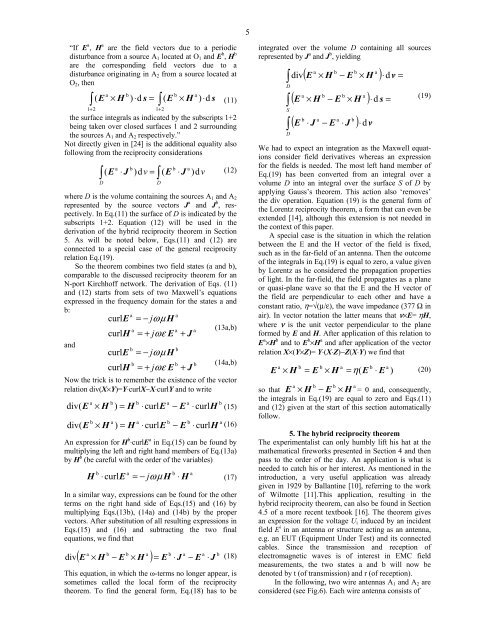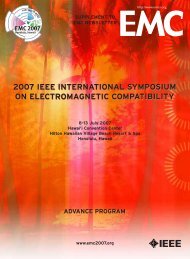reciprocity and emc measurements - IEEE Electromagnetic ...
reciprocity and emc measurements - IEEE Electromagnetic ...
reciprocity and emc measurements - IEEE Electromagnetic ...
You also want an ePaper? Increase the reach of your titles
YUMPU automatically turns print PDFs into web optimized ePapers that Google loves.
5“If E a , H a are the field vectors due to a periodicdisturbance from a source A 1 located at O 1 <strong>and</strong> E b , H bare the corresponding field vectors due to adisturbance originating in A 2 from a source located atO 2 , then∫1+2( Ea× Hb) ⋅ds =1+2( E× H) ⋅ds(11)the surface integrals as indicated by the subscripts 1+2being taken over closed surfaces 1 <strong>and</strong> 2 surroundingthe sources A 1 <strong>and</strong> A 2 respectively.”Not directly given in [24] is the additional equality alsofollowing from the <strong>reciprocity</strong> considerations∫D( Ea⋅ Jb(12)where D is the volume containing the sources A 1 <strong>and</strong> A 2represented by the source vectors J a <strong>and</strong> J b , respectively.In Eq.(11) the surface of D is indicated by thesubscripts 1+2. Equation (12) will be used in thederivation of the hybrid <strong>reciprocity</strong> theorem in Section5. As will be noted below, Eqs.(11) <strong>and</strong> (12) areconnected to a special case of the general <strong>reciprocity</strong>relation Eq.(19).So the theorem combines two field states (a <strong>and</strong> b),comparable to the discussed <strong>reciprocity</strong> theorem for anN-port Kirchhoff network. The derivation of Eqs. (11)<strong>and</strong> (12) starts from sets of two Maxwell’s equationsexpressed in the frequency domain for the states a <strong>and</strong>b:aacurlE= − jω µ Haa a(13a,b)curlH= + jωεE + J<strong>and</strong>bbcurlE= − jω µ Hbb b (14a,b)curlH= + jωεE + JNow the trick is to remember the existence of the vectorrelation div(X×Y)=Y⋅curlX−X⋅curlY <strong>and</strong> to writediv(div(EEab× H× Hba) = H) = H(15)(16)An expression for H b ⋅curlE a in Eq.(15) can be found bymultiplying the left <strong>and</strong> right h<strong>and</strong> members of Eq.(13a)by H b (be careful with the order of the variables)H(17)In a similar way, expressions can be found for the otherterms on the right h<strong>and</strong> side of Eqs.(15) <strong>and</strong> (16) bymultiplying Eqs.(13b), (14a) <strong>and</strong> (14b) by the propervectors. After substitution of all resulting expressions inEqs.(15) <strong>and</strong> (16) <strong>and</strong> subtracting the two finalequations, we find thatdiv(18)This equation, in which the ω-terms no longer appear, issometimes called the local form of the <strong>reciprocity</strong>theorem. To find the general form, Eq.(18) has to be∫∫b a)dv = ( E ⋅ J ) dvbaD⋅curlE⋅curlEba⋅ curlE= − jω µabHb− E− Ebab⋅ Ha⋅curlH⋅curlHa b b a b a a b( E × H − E × H ) = E ⋅ J − E ⋅ Jabaintegrated over the volume D containing all sourcesrepresented by J a <strong>and</strong> J b , yieldinga b b a∫ div( E × H − E × H ) ⋅Da b b a∫ ( E × H − E × H ) ⋅dsSb a a b∫ ( E ⋅ J − E ⋅ J ) ⋅dvDd v =(19)We had to expect an integration as the Maxwell equationsconsider field derivatives whereas an expressionfor the fields is needed. The most left h<strong>and</strong> member ofEq.(19) has been converted from an integral over avolume D into an integral over the surface S of D byapplying Gauss’s theorem. This action also ‘removes’the div operation. Equation (19) is the general form ofthe Lorentz <strong>reciprocity</strong> theorem, a form that can even beextended [14], although this extension is not needed inthe context of this paper.A special case is the situation in which the relationbetween the E <strong>and</strong> the H vector of the field is fixed,such as in the far-field of an antenna. Then the outcomeof the integrals in Eq.(19) is equal to zero, a value givenby Lorentz as he considered the propagation propertiesof light. In the far-field, the field propagates as a planeor quasi-plane wave so that the E <strong>and</strong> the H vector ofthe field are perpendicular to each other <strong>and</strong> have aconstant ratio, η=√(µ/ε), the wave impedance (377 Ω inair). In vector notation the latter means that ν×E= ηH,where ν is the unit vector perpendicular to the planeformed by E <strong>and</strong> H. After application of this relation toE a ×H b <strong>and</strong> to E b ×H a <strong>and</strong> after application of the vectorrelation X×(Y×Z)= Y⋅(X⋅Z)−Z(X⋅Y) we find thata b b aE × H = E × H = η(E(20)a b b aso that E × H − E × H = 0 <strong>and</strong>, consequently,the integrals in Eq.(19) are equal to zero <strong>and</strong> Eqs.(11)<strong>and</strong> (12) given at the start of this section automaticallyfollow.5. The hybrid <strong>reciprocity</strong> theoremThe experimentalist can only humbly lift his hat at themathematical fireworks presented in Section 4 <strong>and</strong> thenpass to the order of the day. An application is what isneeded to catch his or her interest. As mentioned in theintroduction, a very useful application was alreadygiven in 1929 by Ballantine [10], referring to the workof Wilmotte [11].This application, resulting in thehybrid <strong>reciprocity</strong> theorem, can also be found in Section4.5 of a more recent textbook [16]. The theorem givesan expression for the voltage U i induced by an incidentfield E i in an antenna or structure acting as an antenna,e.g. an EUT (Equipment Under Test) <strong>and</strong> its connectedcables. Since the transmission <strong>and</strong> reception ofelectromagnetic waves is of interest in EMC field<strong>measurements</strong>, the two states a <strong>and</strong> b will now bedenoted by t (of transmission) <strong>and</strong> r (of reception).In the following, two wire antennas A 1 <strong>and</strong> A 2 areconsidered (see Fig.6). Each wire antenna consists ofb⋅ E=a)
















